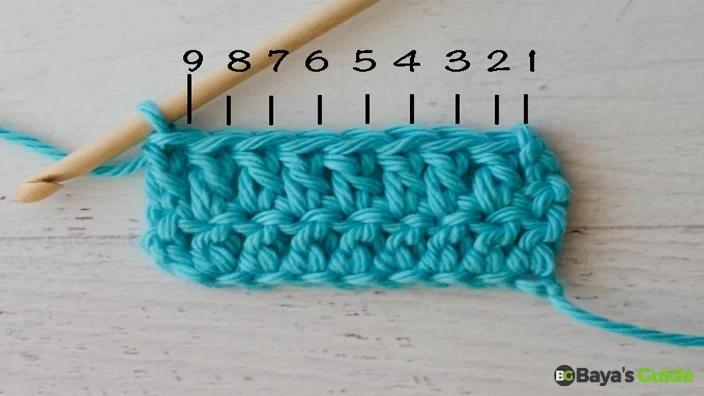In the magical domain of crochet, each stitch and turn is a new page, spinning a story of imagination and virtuosity. Yet, for a lot of them, figuring out the rows and tracing the pattern may be a challenge that becomes too complicated and perplexing. I believe you have experienced the enchanting lull of the crochet rhythm in which you lose track of how many rows you count, haven’t you? Don't be scared; you're not alone! A lot of crocheters report that they have problems with counting rows. It makes them upset and, in some cases, even demands to unravel whole projects. This volume of numbers shows that we need a complete guide for it.
It has to highlight the difficulties as well as provide you with the fail-safe tricks to beat the row-counter conundrum. For it, become a part of us as we connect the threads between you and your garment to form a wonderfully stitched item.
Table of Contents
What Is Crocheting?
Crocheting is making different types of fabrics, interweaving a thread or multiple threads with a hooked noodle called crochet. It is equally popular from East to West, from household to professional ladies. Besides, crocheted objects become top-selling products as the cold season starts. Crocheting is an ideal handy job for the ideal fabric-making like blankets, winter hats, scarves, gloves, bags, and articles of clothing. Crocheting has now become a fruitful and flourishing business across the world.
How To Count Crochet Rows?
No doubt crochet crafting is not that complicated but surely, a bit confusing because you often forget after every two rows how many series you have woven. Each round of crochet looks different in patterns. After going through the different methods given below, the counting of crochet rows will remain nothing but fun.
1- Counting A Flat Crochet
When you need to count the series on a straightened crocheting piece, you should know some tricks to add the rows up.
- Lay your piece of work straight on the table.
- Get the counting go after the bottom chain as the foundation chain is not included in the rows.
- Count the bumps or ridges carefully.
- Buckle the stitch marker or tie the thread after each 10 lines and count them later.
2- Large Stitch
The sizeable stitch is easier to count than the slighter stitch. The size of the crochet intertwining depends on the pattern you have selected for your fabric as following the pattern weave with large suture:
- Single Crochet
- Single Mesh Stitch
- Thick Loop Single Stitch
- Half Double Stitch
- Double Crochet Stitch
- Puff Stitch
- Treble (Triple) Stitch
- V Stitch
- Shell Stitch
- Triple Shell Stitch
In these types of crocheting patterns, the rows are taller and fairly interwoven therefore they are easily counted.
Read More: How To Pray Istikhara
3- Count From The Bottom
If you start counting the rows from the bottom side of your crochet knit, the design gets vividly clear and easier to count up. Remember, the count you begin from the upper side will be confusing because you can’t differentiate between where the series ends and where they start from. For the round form of a pattern, hold your work in a flat place and add up the ridges from the center to the end. In case your pattern is round, count the bumps or holes to track the rows easily.
4- Observe The Holes
With each row you weave, holes of the rows are added. You can easily count all horizontal lines from top to bottom. Each row of holes adds the length of your fabric pulled tight. Lay straight your work and see the holes jutting out at the place the crochet hook enters. See the horizontal line and count them easily. These holes are easily spotted and counted.
5- See The Crease/Ridges
If you are crocheting, your work will naturally form rows on both sides, referred to as ridges. Counting these ridges can help you keep track of your rows. On the other hand, when working on round projects like beanies, the ridges appear on the sides of the object, and you can easily count them to determine the number of rows.
To count these ridges, place your work flat on a surface to keep the ridges in a horizontal position. There's no need to count the foundation chain. Some crafters find it more convenient to count the ridges, while others prefer counting the dashes. Choose the method that works best for you.
6- See The Tail
As an experienced crocheter, you're familiar with how the thread with a knot is typically left at the point where you start making a chain. When you return to the beginning of your work after completing crochet rounds, you'll notice the position of the tail can help you identify the row you've just finished.
For example, when crocheting lengthwise, if you've reached the 19th or 20th row and are uncertain about its number, take a moment to observe the tail. If the tail is on your left side (assuming you're right-handed), you've completed an odd-numbered row. Conversely, if the tail is on your right side, you've just finished an even-numbered row. This simple trick can help you keep track of your progress in your crochet project.
7- Stitch Markers
A stitch maker, no doubt, is a must for crochet intertwining. After completing each row, you keep it shifting on to the next till the top of the stitch. Instead, you keep on counting the ridges or rows after completing the series, better to buckle a stitch maker after each 10 rows and count them at the end. Also, you can develop a simple tally system using marks or symbols for each row worked.
8- Look For The Outer Stitches
In most used crocheting patterns like lemon peel and Moss stitch, the stitches get prominent on the side; they will look the same. These ridges determine the pattern and style of fabric you are weaving. Counting rows is easier while seeing the outermost single crochet stitches.
Frequently Asked Questions
What Is The Difference Between Amigurumi & Crochet?
Amigurumi and crochet are considered the same as both appear in crocheting art. Amigurumi is a Japanese term that stands for the small stuffed-like toys that people made for aesthetic causes. When you say crochet, it’s used specifically for 2D-shaped designs. On the other hand, amigurumi is for 3D shapes that serve crocheted toys, crocheted animals, crocheted dolls, crocheted food, and various decorative objects.
Is Stitch Counting Mandatory in Crochet?
Some people consider the counting of stitches less important while crocheting, but surely, it is not. The crocheter can’t set his/her pattern on the track until the number of stitches should be as per the pattern. There are ridges, edges holes, and bumps inside, and the outermost design (as mentioned above in the article) helps in counting the stitches.
Should I Include The First Row In Crochet Counts?
The first row of crochet, which is typically worked into the foundation chain, does count as one row in your project. When you're counting the total number of crochet rows, it's important to include this initial row. The article provided above details how to count crochet rows accurately, and it emphasizes that you should start counting from this first row, as it's indeed a part of your overall row count.
Conclusion
Bringing up the rear and counting crochet rows is an essential skill for every crocheter, whether you're a beginner or an experienced crafter. By following the methods discussed in this article, such as using stitch markers, creating a single-row system for counting that should work until the last row, and paying attention to your stitch patterns, you can keep track of your progress and create beautifully crafted projects with ease.
Remember that practice makes perfect, and as you continue to crochet, you'll become more proficient at counting rows accurately. Don't be discouraged by occasional mistakes; they're part of the learning process. With patience and dedication, you'll master this skill and unlock endless possibilities for creating stunning crochet creations. Happy crocheting!























